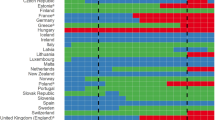Abstract
The study assesses unobserved selection bias in an inpatient diagnostic cost group (DCG) model similar to Medicare's Principal Inpatient Diagnostic Cost Group (PIP-DCG) risk adjustment model using a unique data set that contains hospital discharge records for both FFS and HMO Medicare beneficiaries in California from 1994 to 1996. We use a simultaneous equations model that jointly estimates HMO enrollment and subsequent hospital use to test the existence of unobserved selection and estimate the true HMO effect. It is found that the inpatient DCG model does not adequately adjust for biased selection into Medicare HMOs. New HMO enrollees are healthier than FFS beneficiaries even after adjustment for the included PIP-DCG risk factors. A model developed over an FFS sample ignoring unobserved selection overestimates hospital use of new HMO enrollees by 28 percent compared to their use if they had remained in FFS. Models that better captures selection bias are needed to reduce overestimation of Medicare HMO enrollees' resource use.
Similar content being viewed by others
References
Baker, L., “Association of managed care market share and health expenditures for fee-for-service Medicare patients, ” JAMA 281(5), 432–437, 1999.
Blough, D., Madden, C., and Hornbrook, M., “Modeling risk using generalized linear models, ” Journal of Health Economics 18, 153–171, 1999.
Christensen, S. and Shinogle, J., “Effects of supplemental coverage on use of services by Medicare enrollees, ” Health Care Financing Review 19(1), 5–17, 1997.
Dhanani, N., O'leary, J., Keeler, E., et al., “The effect of HMOs on the inpatient utilization of Medicare beneficiaries, ” Health Services Research, forthcoming.
Dowd, B., Feldman, R., Moscovice, I., et al., “An analysis of unobserved selection in the Medicare AAPCC (adjusted average per capita cost), ” Health Care Financing Review 17(3), 35–57, 1996.
Eggers, P.W. and Prihoda, R, “Pre-enrollment reimbursement patterns of Medicare beneficiaries enrolled in “at-risk” HMOs, ” Health Care Financing Review 4(2), 1982.
Ellis, R., Pope, L., Iezzoni, J., et al., “Diagnosis-based risk adjustment for Medicare capitation payments, ” Health Care Financing Review 18(1), 1996.
General Accounting Office, “Medicare+Choice: Payments exceed cost of fee-for-service benefits, adding billions to spending, ” GAO/HEHS–00–161, 2000.
Goldman, D., Leibowitz, A., and Buchanan, J.L., “Cost-containment and adverse selection in Medicaid HMOs, ” Journal of American Statistical Association 93(441), 54–62, 1998.
Gruenberg, L., Kaganova, E., and Hornbrook, M., “Improving the AAPCC with health-status measures from the MCBS, ” Health Care Financing Review 17(3), 59–75, 1996.
Heckman, J. and Singer, B., “Amethod for minimizing the impact of distributional assumptions in econometric models for duration data, ” Econometrica 52, 271–320, 1984.
Hellinger, F., “Selection bias in HMOs and PPOs: A review of the evidence, ” Inquiry 32, 135–142, 1995.
Hill, J., Brown, R., Chu, D., and Bergeron, J., “The impact of the Medicare risk program on the use of services and costs to Medicare, ” Mathematica Policy Research, Inc., Princeton, NJ, 1992.
Hornbrook, M., Bennett, M., and Greenlick, M., “Adjusting the AAPCC (adjusted average per capita cost) for selectivity and selection bias under Medicare risk contracts, ” Advances in Health Economics and Health Services Research 10, 111–49, JAI, Greenwich, CT, 1989.
Manning W., Leibowitz, A., Goldberg, G., et al., “A controlled trial of the effect of a prepaid group practice on use of services, ” New England Journal of Medicine 310, 1505–1910, 1984.
Medicare Payment Advisory Commission, “Report to the Congress: Improving risk adjustment in Medicare, ” MedPAC, Washington, DC, Nov. 2000.
Melllo, M., Stearns, S., and Norton, E., “Do Medicare HMOs still reduce health services use after controlling for selection bias?” Health Econ. 11, 323–340, 2002.
Miller, R. and Luft, H., “Managed care plan performance since 1980, ” Journal of the American Medical Association 271(19), 1512–1519, 1994.
Mroz, T., “Discrete factor approximations in simultaneous equation models: Estimating the impact of a dummy endogenous variable on a continuous outcome, ” Journal of Econometrics 92, 233–274, 1999.
Newhouse, J., Manning, W., Keeler, E., et al., “Adjusting capitation rates using objective health measurers and prior utilization, ” Health Care Financing Review 10(3), 41–54, 1989.
Physician Payment Review Commission, “Prior research on risk selection in Medicare HMOs, ” PPRC, Washington, DC, 1996.
Pope, G., Ellis, R., Ash, A., et al., “Principal inpatient diagnostic cost group model for Medicare risk adjustment, ” Health Care Financing Review 21(3), 127–135, 2000.
Pope, G., Ellis, R., Ash, A., et al., “Diagnostic cost group hierarchical condition category models for Medicare risk adjustment, ” Final report prepared for Health Care Financing Administration, Dec., 2000.
Riley, G., Lubitz, J., and Rabey, E., “Enrollee health status under Medicare risk contracts: An analysis of mortality rates, ” Health Services Research 26(2), 137–163, 1991.
Robinson, J., “Decline in hospital utilization and cost inflation under managed care in California, ” JAMA 276, 1060–1064, 1996.
Scully, T., Testimony of Thomas A. Scully, Administrator of Centers for Medicare & Medicaid Services, before the House Ways & Means Health Subcommittee on the Medicare+Choice program, Dec. 4, 2001, Accessed on http://cms.hhs.gov in June 2002.
Stata Corporation, Stata 7.0. College Station, TX, 2001.
Van de Ven, W. and Ellis, R., “Risk adjustment in competitive health plan markets, ” in Handbook of health economics. (A. Culyer and J. Newhouse, eds.), Elsevier, New York, NY, vol. 1A, pp. 755–847, 2000.
Welch, W., “Medicare capitation payments to HMOs in light of regression toward the mean in health care costs, ” Advances in Health Economics and Health Services Research 6, 75–96, JAI, Greenwich, CT, 1985.
Author information
Authors and Affiliations
Corresponding author
Rights and permissions
About this article
Cite this article
Kan, H., Goldman, D., Keeler, E. et al. An Analysis of Unobserved Selection in an Inpatient Diagnostic Cost Group Model. Health Services & Outcomes Research Methodology 4, 71–91 (2003). https://doi.org/10.1023/B:HSOR.0000027921.40194.9d
Issue Date:
DOI: https://doi.org/10.1023/B:HSOR.0000027921.40194.9d




